Weã¢â‚¬â„¢ll Meet Again the Breakdown of Family Relationships After World War Two
*The American Yawp is an evolving, collaborative text. Delight click here to better this chapter.*
- I. Introduction
- 2. Industrialization & Technological Innovation
- III. Immigration and Urbanization
- 4. The New South and the Problem of Race
- 5. Gender, Religion, and Culture
- Six. Conclusion
- Vii. Master Sources
- VIII. Reference Material
I. Introduction
When British writer Rudyard Kipling visited Chicago in 1889, he described a city absorbed by technology and blinded past greed. He described a rushed and crowded city, a "huge wilderness" with "scores of miles of these terrible streets" and their "hundred thou of these terrible people." "The testify impressed me with a great horror," he wrote. "There was no color in the street and no dazzler—merely a maze of wire ropes overhead and muddied stone flagging under foot." He took a cab "and the cabman said that these things were the proof of progress." Kipling visited a "gilded and mirrored" hotel "crammed with people talking about coin, and spitting virtually everywhere." He visited extravagant churches and spoke with their congregants. "I listened to people who said that the mere fact of spiking down strips of atomic number 26 to woods, and getting a steam and fe affair to run along them was progress, that the telephone was progress, and the network of wires overhead was progress. They repeated their statements again and again." Kipling said American newspapers report "that the snarling together of telegraph-wires, the heaving up of houses, and the making of money is progress."ane
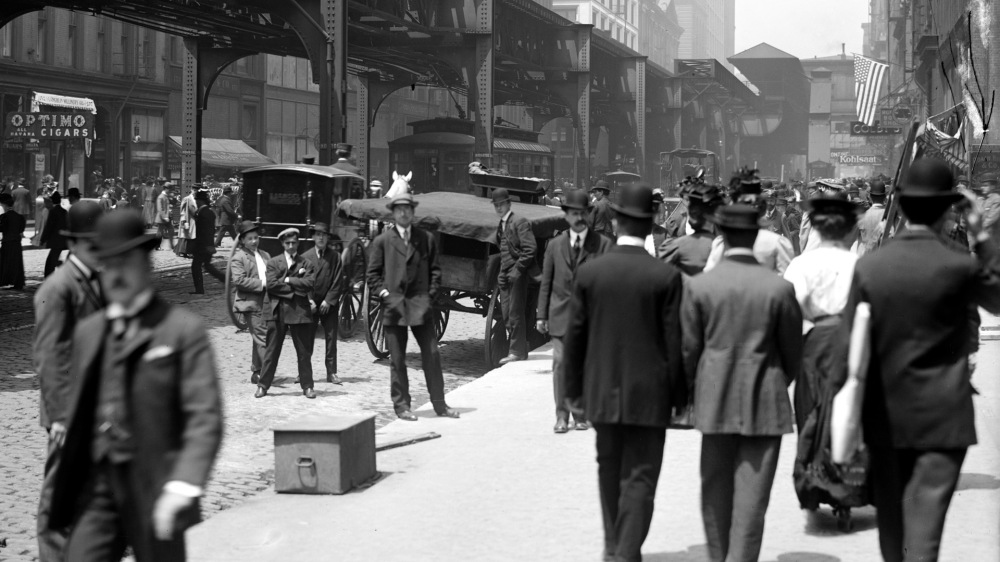
Wabash Avenue, Chicago, c. 1907. Library of Congress, LC-D4-70163.
Chicago embodied the triumph of American industrialization. Its meatpacking industry typified the sweeping changes occurring in American life. The last decades of the nineteenth century, a new era for large business organization, saw the formation of large corporations, run by trained bureaucrats and salaried managers, doing national and international business. Chicago, for case, became America'southward butcher. The Chicago meat processing industry, a cartel of five firms, produced four fifths of the meat bought by American consumers. Kipling described in intimate item the Union Stock Yards, the nation'due south largest meat processing zone, a square mile simply southwest of the city whose pens and slaughterhouses linked the city'due south vast agricultural hinterland to the nation's dinner tables. "Once having seen them," he concluded, "yous will never forget the sight." Similar other notable Chicago industries, such as agricultural machinery and steel production, the meatpacking industry was closely tied to urbanization and immigration. In 1850, Chicago had a population of about thirty chiliad. Twenty years later, it had three hundred m. Nothing could finish the city's growth. The Cracking Chicago Burn leveled 3.5 square miles and left a 3rd of its residents homeless in 1871, but the city quickly recovered and resumed its spectacular growth. By the turn of the twentieth century, the city was domicile to 1.7 million people.
Chicago's explosive growth reflected national trends. In 1870, a quarter of the nation'due south population lived in towns or cities with populations greater than 2,500. By 1920, a majority did. Simply if many who flocked to Chicago and other American cities came from rural America, many others emigrated from overseas. Mirroring national clearing patterns, Chicago'south newcomers had at first come mostly from Germany, the British Isles, and Scandinavia, but, by 1890, Poles, Italians, Czechs, Hungarians, Lithuanians, and others from southern and eastern Europe made upwardly a majority of new immigrants. Chicago, like many other American industrial cities, was also an immigrant urban center. In 1900, nearly 80 pct of Chicago's population was either strange-born or the children of strange-born immigrants.2
Kipling visited Chicago simply as new industrial modes of production revolutionized the United States. The ascent of cities, the evolution of American clearing, the transformation of American labor, the farther making of a mass civilisation, the creation of great concentrated wealth, the growth of vast city slums, the conquest of the West, the emergence of a eye class, the trouble of poverty, the triumph of big concern, widening inequalities, battles betwixt majuscule and labor, the final destruction of independent farming, breakthrough technologies, ecology destruction: industrialization created a new America.
II. Industrialization & Technological Innovation
The railroads created the kickoff great concentrations of capital, spawned the first massive corporations, fabricated the first of the vast fortunes that would define the Gilt Age, unleashed labor demands that united thousands of farmers and immigrants, and linked many towns and cities. National railroad mileage tripled in the xx years afterwards the outbreak of the Civil War, and tripled again over the four decades that followed. Railroads impelled the creation of uniform time zones across the state, gave industrialists admission to remote markets, and opened the American West. Railroad companies were the nation'southward largest businesses. Their vast national operations demanded the cosmos of innovative new corporate organization, advanced management techniques, and vast sums of capital. Their huge expenditures spurred endless industries and attracted droves of laborers. And every bit they crisscrossed the nation, they created a national market, a truly national economy, and, seemingly, a new national culture.3
The railroads were not natural creations. Their vast capital requirements required the use of incorporation, a legal innovation that protected shareholders from losses. Enormous amounts of government support followed. Federal, land, and local governments offered unrivaled handouts to create the national rail networks. Lincoln'southward Republican Party—which dominated regime policy during the Civil State of war and Reconstruction—passed legislation granting vast subsidies. Hundreds of millions of acres of land and millions of dollars' worth of government bonds were freely given to build the dandy transcontinental railroads and the innumerable trunk lines that chop-chop annihilated the vast geographic barriers that had and then long sheltered American cities from ane another.
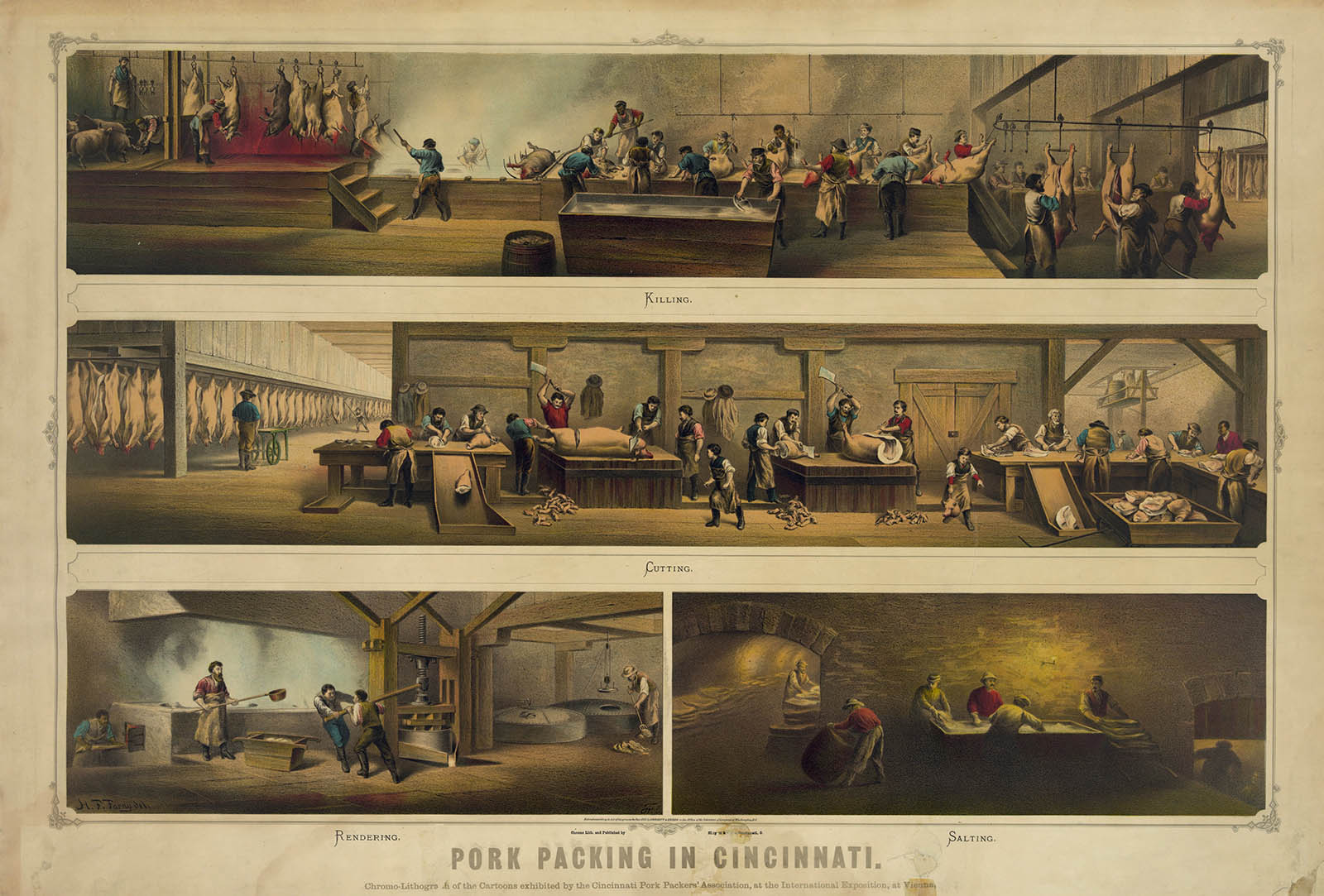
This print shows the four stages of pork packing in nineteenth-century Cincinnati. This centralization of production fabricated meat-packing an innovative industry, ane of bang-up interest to industrialists of all ilks. In fact, this chromo-lithograph was exhibited by the Cincinnati Pork Packers' Clan at the International Exposition in Vienna, Republic of austria. 1873. Wikimedia.
As railroad structure drove economical development, new means of production spawned new systems of labor. Many wage earners had traditionally seen factory piece of work as a temporary stepping-stone to attaining their own small-scale businesses or farms. Later the state of war, nevertheless, new applied science and greater mechanization meant fewer and fewer workers could legitimately aspire to economical independence. Stronger and more organized labor unions formed to fight for a growing, more-permanent working class. At the aforementioned fourth dimension, the growing calibration of economic enterprises increasingly disconnected owners from their employees and solar day-to-day business operations. To handle their vast new operations, owners turned to managers. Educated bureaucrats swelled the ranks of an emerging centre form.
Industrialization also remade much of American life exterior the workplace. Speedily growing industrialized cities knit together urban consumers and rural producers into a single, integrated national market. Food production and consumption, for instance, were utterly nationalized. Chicago's stockyards seemingly tied it all together. Between 1866 and 1886, ranchers collection a million caput of cattle annually overland from Texas ranches to railroad depots in Kansas for shipment by rail to Chicago. After travelling through modern "disassembly lines," the animals left the bordering slaughterhouses as slabs of meat to be packed into refrigerated track cars and sent to butcher shops across the continent. By 1885, a handful of big-scale industrial meatpackers in Chicago were producing nearly v hundred meg pounds of "dressed" beef annually.4 The new calibration of industrialized meat product transformed the landscape. Buffalo herds, grasslands, and old-growth forests gave way to cattle, corn, and wheat. Chicago became the Gateway City, a crossroads connecting American agricultural appurtenances, capital letter markets in New York and London, and consumers from all corners of the United States.
Technological innovation accompanied economic development. For Apr Fool's Day in 1878, the New York Daily Graphic published a fictitious interview with the celebrated inventor Thomas A. Edison. The piece described the "biggest invention of the historic period"—a new Edison machine that could create forty different kinds of food and potable out of only air, water, and dirt. "Meat will no longer exist killed and vegetables no longer grown, except past savages," Edison promised. The automobile would end "famine and pauperism." And all for $five or $half dozen per machine! The story was a joke, of course, only Edison notwithstanding received inquiries from readers wondering when the food automobile would be ready for the market. Americans had apparently witnessed such startling technological advances—advances that would have seemed far-fetched mere years earlier—that the Edison food machine seemed entirely plausible.v
In September 1878, Edison announced a new and ambitious line of research and evolution—electric power and lighting. The scientific principles behind dynamos and electric motors—the conversion of mechanical free energy to electrical ability, and vice versa—were long known, but Edison applied the historic period's bureaucratic and commercial ethos to the trouble. Far from a solitary inventor gripped by inspiration toiling in isolation, Edison advanced the model of commercially minded management of inquiry and development. Edison folded his two identities, concern manager and inventor, together. He called his Menlo Park research laboratory an "invention factory" and promised to plough out "a small-scale invention every x days and a large affair every six months or so." He brought his fully equipped Menlo Park enquiry laboratory and the skilled machinists and scientists he employed to touch on the problem of building an electric ability system—and commercializing information technology.
By belatedly fall 1879, Edison exhibited his system of power generation and electrical light for reporters and investors. Then he scaled up production. He sold generators to businesses. By the heart of 1883, Edison had overseen structure of 330 plants powering over sixty thousand lamps in factories, offices, printing houses, hotels, and theaters around the world. He convinced municipal officials to build fundamental ability stations and run power lines. New York's Pearl Street central station opened in September 1882 and powered a square mile of downtown Manhattan. Electricity revolutionized the world. Information technology non only illuminated the night, information technology powered the 2nd Industrial Revolution. Factories could operate anywhere at whatsoever hour. Electric rail cars allowed for cities to build out and electric elevators allowed for them to build up.
Economical advances, technological innovation, social and cultural evolution, demographic changes: the U.s. was a nation transformed. Industry boosted productivity, railroads connected the nation, more and more Americans labored for wages, new bureaucratic occupations created a vast "white collar" middle class, and unprecedented fortunes rewarded the owners of capital. These revolutionary changes, of course, would not occur without conflict or consequence (meet Affiliate 16), just they demonstrated the profound transformations remaking the nation. Modify was not confined to economics alone. Change gripped the lives of everyday Americans and fundamentally reshaped American culture.6
III. Immigration and Urbanization
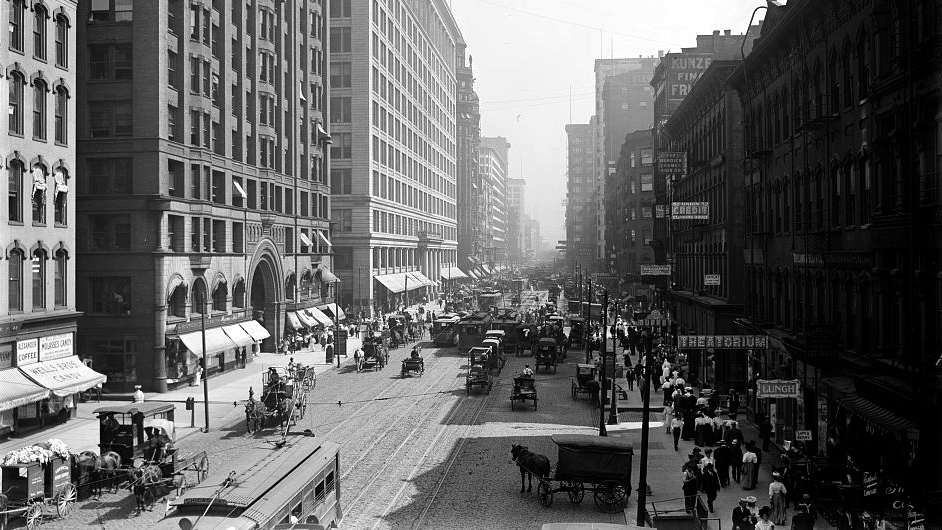
Country Street, southward from Lake Street, Chicago, Ill, ca.1900-1910. Library of Congress, LC-D4-70158.
Industry pulled ever more than Americans into cities. Manufacturing needed the labor pool and the infrastructure. America's urban population increased sevenfold in the half century later on the Ceremonious State of war. Shortly the Usa had more large cities than any land in the globe. The 1920 U.S. demography revealed that, for the first fourth dimension, a majority of Americans lived in urban areas. Much of that urban growth came from the millions of immigrants pouring into the nation. Between 1870 and 1920, over twenty-five meg immigrants arrived in the Us.
By the turn of the twentieth century, new immigrant groups such as Italians, Poles, and Eastern European Jews made up a larger percentage of arrivals than the Irish and Germans. The specific reasons that immigrants left their particular countries and the reasons they came to the United States (what historians call push and pull factors) varied. For example, a young husband and wife living in Sweden in the 1880s and unable to purchase farmland might read an ad for inexpensive country in the American Midwest and immigrate to the United States to begin a new life. A young Italian man might simply hope to labor in a steel factory long plenty to save upward plenty coin to return home and purchase land for a family. A Russian Jewish family unit persecuted in European pogroms might expect to the Usa equally a sanctuary. Or perhaps a Japanese migrant might hear of fertile farming state on the West Coast and choose to canvas for California. But if many factors pushed people away from their abode countries, by far the most of import factor drawing immigrants was economic science. Immigrants came to the The states looking for work.
Industrial capitalism was the most important cistron that drew immigrants to the United States between 1880 and 1920. Immigrant workers labored in large industrial complexes producing goods such as steel, textiles, and food products, replacing smaller and more local workshops. The influx of immigrants, alongside a big movement of Americans from the countryside to the city, helped propel the rapid growth of cities like New York, Pittsburgh, Cleveland, Milwaukee, and St. Louis. By 1890, immigrants and their children deemed for roughly 60 percentage of the population in most large northern cities (and sometimes as high as 80 or ninety pct). Many immigrants, peculiarly from Italia and the Balkans, always intended to return dwelling house with enough coin to purchase state. But what nearly those who stayed? Did the new arrivals digest together in the American melting pot—becoming just like those already in the United States—or did they retain, and sometimes even strengthen, their traditional ethnic identities? The reply lies somewhere in between. Immigrants from specific countries—and often even specific communities—often amassed together in ethnic neighborhoods. They formed vibrant organizations and societies, such equally Italian workmen's clubs, Eastern European Jewish common aid societies, and Smooth Catholic churches, to ease the transition to their new American home. Immigrant communities published newspapers in dozens of languages and purchased spaces to go on their arts, languages, and traditions alive. And from these foundations they facilitated even more immigration: afterward staking out a claim to some corner of American life, they wrote home and encouraged others to follow them (historians call this chain migration).
Many cities' politics adapted to immigrant populations. The infamous urban political machines oftentimes operated as a kind of mutual aid society. New York Urban center'southward Democratic Party auto, popularly known as Tammany Hall, drew the greatest ire from critics and seemed to embody all of the worst of metropolis machines, merely information technology too responded to immigrant needs. In 1903, journalist William Riordon published a book, Plunkitt of Tammany Hall, which chronicled the activities of ward heeler George Washington Plunkitt. Plunkitt elaborately explained to Riordon the difference between "honest graft" and "quack graft": "I fabricated my pile in politics, but, at the same fourth dimension, I served the organization and got more big improvements for New York Metropolis than whatever other livin' man." While exposing corruption, Riordon likewise revealed the difficult work Plunkitt undertook on behalf of his largely immigrant constituency. On a typical day, Riordon wrote, Plunkitt was awakened at 2 a.m. to bail out a saloonkeeper who stayed open too late, was awakened again at six a.m. because of a fire in the neighborhood and spent time finding lodgings for the families displaced by the fire, and, after spending the rest of the morn in courtroom to secure the release of several of his constituents, found jobs for 4 unemployed men, attended an Italian funeral, visited a church social, and dropped in on a Jewish hymeneals. He returned dwelling house at midnight.7
Tammany Hall'south corruption, peculiarly under the reign of William "Boss" Tweed, was legendary, but the public works projects that funded Tammany Hall's graft also provided essential infrastructure and public services for the city's speedily expanding population. Water, sewer, and gas lines; schools, hospitals, civic buildings, and museums; police and burn down departments; roads, parks (notably Central Park), and bridges (notably the Brooklyn Bridge): all could, in whole or in part, be credited to Tammany'due south reign. Still, machine politics could never be enough. As the urban population exploded, many immigrants found themselves trapped in crowded, offense-ridden slums. Americans eventually took notice of this urban crisis and proposed municipal reforms simply as well grew concerned well-nigh the declining quality of life in rural areas.
While cities boomed, rural worlds languished. Some Americans scoffed at rural backwardness and reveled in the countryside'southward decay, but many romanticized the countryside, celebrated rural life, and wondered what had been lost in the cities. Sociologist Kenyon Butterfield, concerned by the sprawling nature of industrial cities and suburbs, regretted the eroding social position of rural citizens and farmers: "Agronomics does not concord the same relative rank among our industries that it did in former years." Butterfield saw "the subcontract problem" equally office of "the whole question of democratic civilization."8 He and many others thought the rise of the cities and the fall of the countryside threatened traditional American values. Many proposed conservation. Freedom Hyde Bailey, a botanist and rural scholar selected by Theodore Roosevelt to chair a federal Commission on State Life in 1907, believed that rural places and industrial cities were linked: "Every agricultural question is a city question."nine
Many longed for a eye path between the cities and the country. New suburban communities on the outskirts of American cities defined themselves in opposition to urban crowding. Americans contemplated the complicated relationships between rural places, suburban living, and urban spaces. Los Angeles became a model for the suburban development of rural places. Dana Barlett, a social reformer in Los Angeles, noted that the metropolis, stretching across dozens of small towns, was "a improve metropolis" because of its residential identity as a "metropolis of homes."x This language was seized upon by many suburbs that hoped to avert both urban sprawl and rural disuse. In Glendora, one of these small towns on the outskirts of Los Angeles, local leaders were "loath equally anyone to see it go cosmopolitan." Instead, in order to have Glendora "abound along the lines necessary to have information technology remain an enjoyable city of homes," they needed to "bestir ourselves to direct its growth" by encouraging not industry or agronomics but residential evolution.xi
Four. The New South and the Trouble of Race
"There was a S of slavery and secession," Atlanta Constitution editor Henry Grady proclaimed in an 1886 voice communication in New York. "That S is dead."12 Grady captured the sentiment of many white southern concern and political leaders who imagined a New South that could plough its back to the past by embracing industrialization and diversified agriculture. He promoted the region's economic possibilities and mutual future prosperity through an alliance of northern capital and southern labor. Grady and other New Southward boosters hoped to shape the region's economy in the North's paradigm. They wanted industry and they wanted infrastructure. But the past could not be escaped. Economically and socially, the "New Southward" would still be much like the sometime.
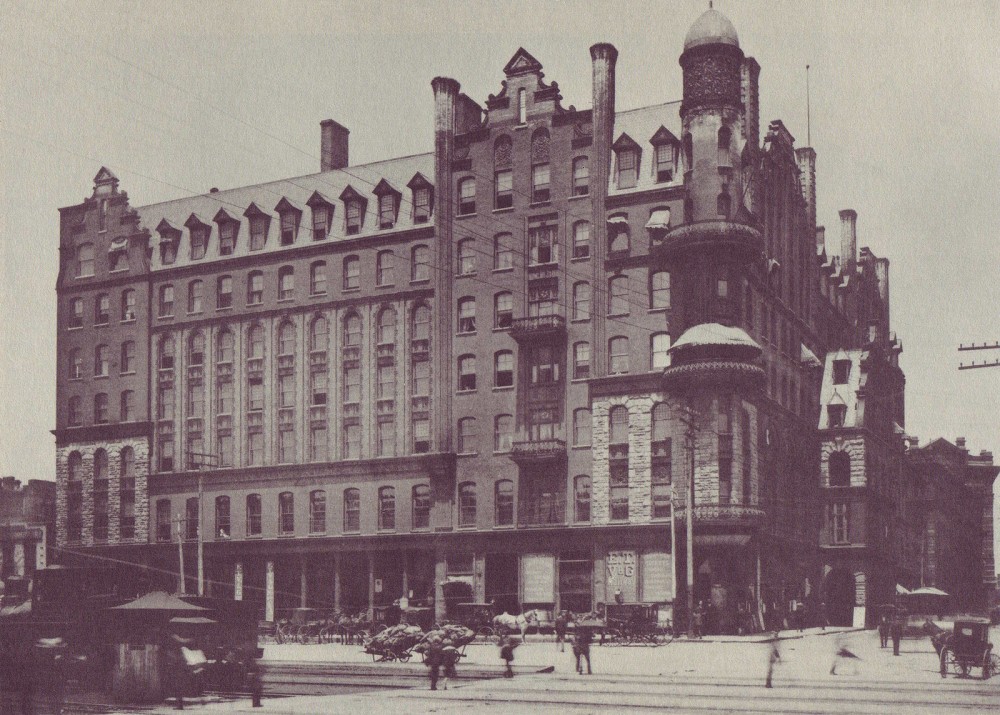
The ambitions of Atlanta, seen in the construction of such g buildings as the Kimball House Hotel, reflected the larger regional aspirations of the and then-called New Due south. 1890. Wikimedia.
A "New South" seemed an obvious need. The Confederacy'southward failed insurrection wreaked havoc on the southern economy and bedridden southern prestige. Property was destroyed. Lives were lost. Political ability vanished. And four million enslaved Americans—representing the wealth and power of the antebellum white South—threw off their chains and walked proudly forwards into freedom.
Emancipation unsettled the southern social order. When Reconstruction regimes attempted to grant freedpeople full citizenship rights, anxious whites struck back. From their fearfulness, anger, and resentment they lashed out, not but in organized terrorist organizations such as the Ku Klux Klan only in political corruption, economic exploitation, and trigger-happy intimidation. White southerners took back control of land and local governments and used their reclaimed power to disenfranchise African Americans and pass "Jim Crow" laws segregating schools, transportation, employment, and various public and private facilities. The reestablishment of white supremacy afterwards the "redemption" of the South from Reconstruction contradicted proclamations of a "New" Due south. Maybe zip harked then forcefully back to the barbaric southern past than the wave of lynchings—the extralegal murder of individuals by vigilantes—that washed across the South after Reconstruction. Whether for actual crimes or fabricated crimes or for no crimes at all, white mobs murdered roughly 5 thousand African Americans between the 1880s and the 1950s.
Lynching was not only murder, it was a ritual rich with symbolism. Victims were not simply hanged, they were mutilated, burned live, and shot. Lynchings could become carnivals, public spectacles attended by thousands of eager spectators. Rail lines ran special cars to accommodate the rush of participants. Vendors sold appurtenances and keepsakes. Perpetrators posed for photos and collected mementos. And it was increasingly common. One notorious example occurred in Georgia in 1899. Accused of killing his white employer and raping the human being's wife, Sam Hose was captured by a mob and taken to the town of Newnan. Word of the impending lynching quickly spread, and specially chartered passenger trains brought some four thousand visitors from Atlanta to witness the gruesome affair. Members of the mob tortured Hose for about an hour. They sliced off pieces of his body as he screamed in agony. And so they poured a can of kerosene over his torso and burned him alive.13
At the barbaric pinnacle of southern lynching, in the last years of the nineteenth century, southerners lynched two to iii African Americans every calendar week. In general, lynchings were most frequent in the Cotton wool Belt of the Lower South, where southern Black people were near numerous and where the majority worked as tenant farmers and field easily on the cotton fiber farms of white landowners. United states of Mississippi and Georgia had the greatest number of recorded lynchings: from 1880 to 1930, Mississippi lynch mobs killed over v hundred African Americans; Georgia mobs murdered more than than iv hundred.
Throughout the tardily nineteenth and early twentieth centuries, a number of prominent southerners openly supported lynching, arguing that it was a necessary evil to punish Black rapists and deter others. In the late 1890s, Georgia paper columnist and noted women's rights activist Rebecca Latimer Felton—who would afterward become the first adult female to serve in the U.S. Senate—endorsed such extrajudicial killings. She said, "If it takes lynching to protect women's honey possession from drunken, ravening beasts, then I say lynch a thousand a week."14 When opponents argued that lynching violated victims' ramble rights, South Carolina governor Coleman Blease angrily responded, "Whenever the Constitution comes between me and the virtue of the white women of Due south Carolina, I say to hell with the Constitution."fifteen
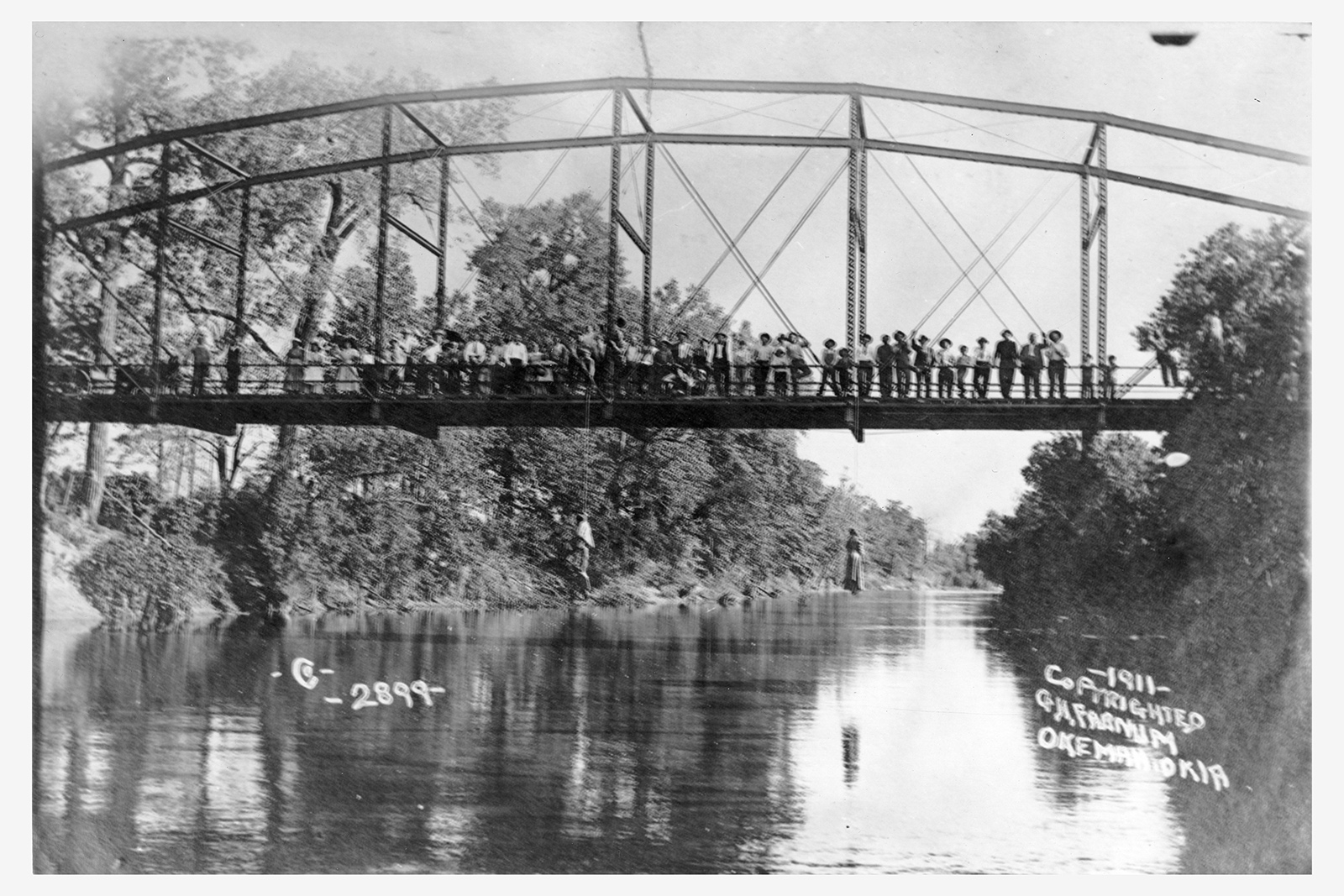
This photo captures the lynching of Laura and Lawrence Nelson, a mother and son, on May 25, 1911, in Okemah, Oklahoma. In response to national attention, the local white paper in Okemah but wrote, "While the general sentiment is adverse to the method, it is mostly thought that the negroes got what would take been due them nether due procedure of law." Wikimedia.
Black activists and white allies worked to outlaw lynching. Ida B. Wells, an African American woman born in the concluding years of slavery and a pioneering anti-lynching abet, lost 3 friends to a lynch mob in Memphis, Tennessee, in 1892. That yr, Wells published Southern Horrors: Lynch Police in All Its Phases, a groundbreaking work that documented the South'due south lynching civilization and exposed the myth of the Black rapist.xvi The Tuskegee Institute and the NAACP both compiled and publicized lists of every reported lynching in the Usa. In 1918, Representative Leonidas Dyer of Missouri introduced federal anti-lynching legislation that would have made local counties where lynchings took place legally liable for such killings. Throughout the early on 1920s, the Dyer Bill was the subject of heated political fence, just, fiercely opposed by southern congressmen and unable to win enough northern champions, the proposed bill was never enacted.
Lynching was non simply the form of racial violence that survived Reconstruction. White political violence connected to follow African American political participation and labor organization, still severely confining. When the Populist insurgency created new opportunities for blackness political activism, white Democrats responded with terror. In N Carolina, Populists and Republicans "fused" together and won stunning electoral gains in 1896. Shocked White Democrats formed "Ruddy Shirt" groups, paramilitary organizations dedicated to eradicating black political participation and restoring Democratic rule through violence and intimidation. Launching a self-described "white supremacy campaign" of violence and intimidation against black voters and officeholders during the 1898 state elections, the Red Shirts effectively took back state government. Just municipal elections were non held that year in Wilmington, where Fusionists controlled city government. After manning armed barricades blocking black voters from inbound the boondocks to vote in the state elections, the Red Shirts drafted a "White Declaration of Independence" which declared "that that we will no longer exist ruled and will never once more be ruled, by men of African origin." 457 white Democrats signed the document. They as well issued a twelve-hour ultimatum that editor of the city'south black daily paper abscond the metropolis. The editor left, just it wasn't plenty. Twelve hours later, hundreds of Red Shirts raided the city'south arsenal and ransacked the paper office anyway. The mob swelled and turned on the city'southward black neighborhood, destroying homes and businesses and opening fire on any Black person they found. Dozens were killed and hundreds more fled the metropolis. The mob and then forced the mayor, the city's aldermen, and the police chief, at gun signal, to immediately resign. To ensure their gains, the Democrats rounded up prominent fusionists, placed them on railroad cars, and, nether armed baby-sit, sent them out of the land. The mob installed and swore in their own replacements. It was a total-blown coup.
Lynching and organized terror campaigns were just the violent worst of the S's racial world. Discrimination in employment and housing and the legal segregation of public and private life likewise reflected the rise of a new Jim Crow S. So-chosen Jim Crow laws legalized what custom had long dictated. Southern states and municipalities enforced racial segregation in public places and in private lives. Divide motorbus laws were some of the first such laws to appear, beginning in Tennessee in the 1880s. Shortly schools, stores, theaters, restaurants, bathrooms, and well-nigh every other part of public life were segregated. And so too were social lives. The sin of racial mixing, critics said, had to be heavily guarded against. Wedlock laws regulated against interracial couples, and white men, ever anxious of relationships between Black men and white women, passed miscegenation laws and justified lynching as an appropriate extralegal tool to police the racial divide.
In politics, de facto limitations of Black voting had suppressed Black voters since Reconstruction. Whites stuffed ballot boxes and intimidated Black voters with physical and economical threats. And then, from roughly 1890 to 1908, southern states implemented de jure, or legal, disfranchisement. They passed laws requiring voters to pass literacy tests (which could be judged arbitrarily) and pay poll taxes (which hit poor white and poor Blackness Americans alike), effectively denying Blackness men the franchise that was supposed to accept been guaranteed past the Fifteenth Amendment. Those responsible for such laws posed as reformers and justified voting restrictions equally for the public skillful, a way to clean upward politics past purging corrupt African Americans from the voting rolls.
With white supremacy secured, prominent white southerners looked outward for back up. New S boosters hoped to confront post-Reconstruction uncertainties past rebuilding the South's economy and convincing the nation that the S could be more than an economically backward, race-obsessed backwater. And as they did, they began to retell the history of the recent past. A kind of civic religion known equally the "Lost Crusade" glorified the Confederacy and romanticized the Old Southward. White southerners looked forward while simultaneously harking back to a mythic imagined by inhabited by contented and loyal slaves, benevolent and generous masters, chivalric and honorable men, and pure and faithful southern belles. Secession, they said, had little to exercise with the institution of slavery, and soldiers fought just for home and award, not the connected ownership of homo beings. The New Due south, then, would be built physically with new technologies, new investments, and new industries, but undergirded by political and social custom.
Henry Grady might have declared the Confederate South expressionless, but its memory pervaded the thoughts and actions of white southerners. Lost Cause champions overtook the Due south. Women's groups, such as the United Daughters of the Confederacy, joined with Amalgamated veterans to preserve a pro-Amalgamated past. They built Confederate monuments and celebrated Confederate veterans on Memorial Day. Beyond the South, towns erected statues of Full general Robert East. Lee and other Amalgamated figures. Past the turn of the twentieth century, the idealized Lost Cause past was entrenched not just in the Southward merely across the country. In 1905, for instance, N Carolinian Thomas F. Dixon published a novel, The Clansman, which depicted the Ku Klux Klan as heroic defenders of the South against the corruption of African American and northern "carpetbag" misrule during Reconstruction. In 1915, acclaimed moving-picture show director David W. Griffith adapted Dixon's novel into the groundbreaking blockbuster moving-picture show, Birth of a Nation. (The film almost singlehandedly rejuvenated the Ku Klux Klan.) The romanticized version of the antebellum Due south and the distorted version of Reconstruction dominated popular imagination.17
While Lost Cause defenders mythologized their by, New Southward boosters struggled to wrench the South into the modern globe. The railroads became their focus. The region had lagged behind the North in the railroad edifice boom of the midnineteenth century, and postwar expansion facilitated connections betwixt the most rural segments of the population and the region'south rising urban areas. Boosters campaigned for the construction of new hard-surfaced roads as well, arguing that improved roads would further increase the menstruation of appurtenances and people and entice northern businesses to relocate to the region. The rise popularity of the motorcar afterward the plough of the century only increased pressure for the construction of reliable roads betwixt cities, towns, county seats, and the vast farmlands of the S.
Along with new transportation networks, New South boosters continued to promote industrial growth. The region witnessed the rise of diverse manufacturing industries, predominantly textiles, tobacco, article of furniture, and steel. While agriculture—cotton in particular—remained the mainstay of the region'southward economy, these new industries provided new wealth for owners, new investments for the region, and new opportunities for the exploding number of landless farmers to finally flee the country. Industries offered low-paying jobs merely also opportunity for rural poor who could no longer sustain themselves through subsistence farming. Men, women, and children all moved into wage work. At the turn of the twentieth century, nigh one fourth of southern mill workers were children aged six to sixteen.
In virtually cases, as in about aspects of life in the New S, new manufacturing plant jobs were racially segregated. Amend-paying jobs were reserved for whites, while the near dangerous, labor-intensive, dirtiest, and lowest-paying positions were relegated to African Americans. African American women, shut out of most industries, institute employment most often as domestic aid for white families. Every bit poor every bit white southern mill workers were, southern Black people were poorer. Some white mill workers could even beget to pay for domestic aid in caring for young children, cleaning houses, doing laundry, and cooking meals. Manufacturing plant villages that grew up alongside factories were whites-but, and African American families were pushed to the outer perimeter of the settlements.
That a "New South" emerged in the decades between Reconstruction and Earth War I is debatable. If measured past industrial output and railroad construction, the New South was a reality simply if measured relative to the remainder of the nation, it was a limited i. If measured in terms of racial discrimination, however, the New South looked much like the Old. Boosters such every bit Henry Grady said the Southward was done with racial questions but lynching and segregation and the institutionalization of Jim Crow exposed the Southward's lingering racial obsessions. Meanwhile, most southerners nevertheless toiled in agronomics and all the same lived in poverty. Industrial development and expanding infrastructure, rather than re-creating the Southward, coexisted easily with white supremacy and an impoverished agronomical economy. The trains came, factories were built, and capital was invested, but the region remained mired in poverty and racial apartheid. Much of the "New South," then, was annihilation simply new.
Five. Gender, Faith, and Culture
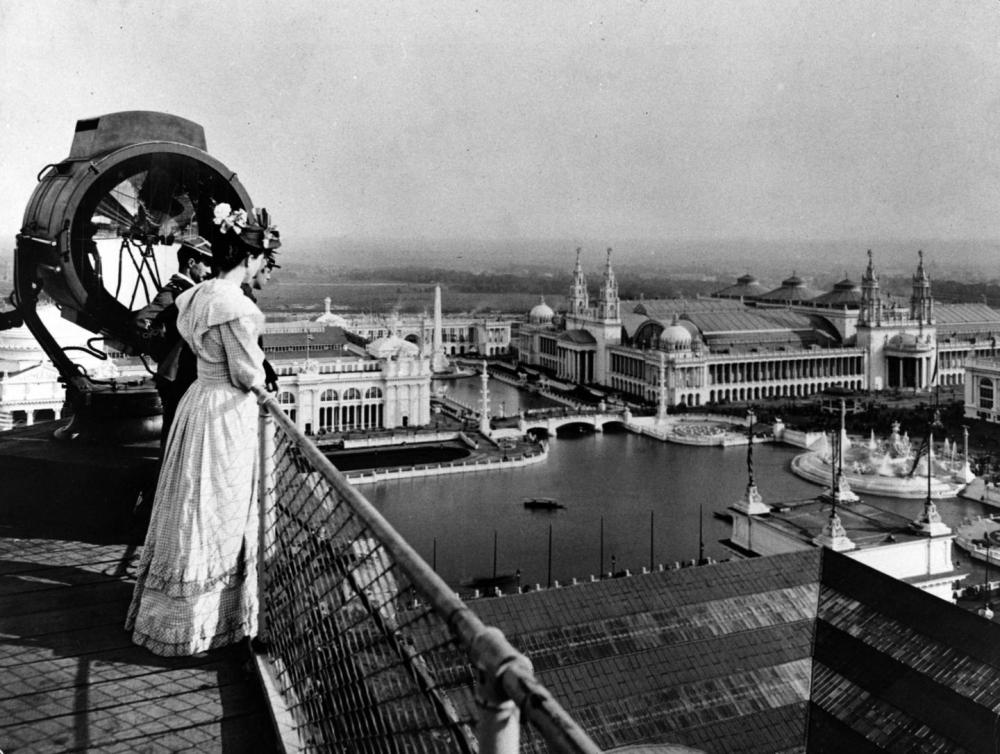
Visitors to the Columbian Exposition of 1893 took in the view of the Court of Honor from the roof of the Manufacturers Building. Art Constitute of Chicago, via Wikimedia
In 1905, Standard Oil tycoon John D. Rockefeller donated $100,000 (about $2.5 million today) to the American Lath of Commissioners for Foreign Missions. Rockefeller was the richest human being in America but also ane of the most hated and mistrusted. Even admirers conceded that he achieved his wealth through ofttimes illegal and usually immoral business practices. Journalist Ida Tarbell had made waves describing Standard Oil's long-standing ruthlessness and predilections for political corruption. Clergymen, led by reformer Washington Gladden, fiercely protested the donation. A decade earlier, Gladden had asked of such donations, "Is this clean money? Can whatever man, can any institution, knowing its origin, touch it without beingness defiled?" Gladden said, "In the cool brutality with which properties are wrecked, securities destroyed, and people by the hundreds robbed of their fiddling all to build up the fortunes of the multi-millionaires, we accept an appalling revelation of the kind of monster that a homo beingness may become."eighteen
Despite widespread criticism, the board accepted Rockefeller's donation. Board president Samuel Capen did not defend Rockefeller, arguing that the souvenir was charitable and the board could non assess the origin of every donation, only the dispute shook Capen. Was a corporate background incompatible with a religious system? The "tainted coin contend" reflected questions well-nigh the proper human relationship between organized religion and capitalism. With rising income inequality, would religious groups be forced to support either the aristocracy or the disempowered? What was moral in the new industrial United states of america? And what obligations did wealth bring? Steel magnate Andrew Carnegie popularized the idea of a "gospel of wealth" in an 1889 article, claiming that "the true antidote for the temporary diff distribution of wealth" was the moral obligation of the rich to give to charity.xix Farmers and labor organizers, meanwhile, argued that God had blest the weak and that new Gilded Age fortunes and corporate management were inherently immoral. As time passed, American churches increasingly adapted themselves to the new industrial order. Fifty-fifty Gladden came to accept donations from the and so-called robber barons, such as the Baptist John D. Rockefeller, who increasingly touted the morality of business concern.
Secular knowledge-seeking and Gilded Historic period dollars increasingly muscled out the traditional role of faith in American higher education too. The Gilded Age aristocracy funneled their fortunes into new elite private institutions. The Morrill Land Grants of 1862 and 1890 subsidized new schools that emphasized practical knowledge in science, technology, and agronomics. The 1890 Act likewise provided for Black colleges in states with segregated universities, 9 years subsequently Booker T. Washington founded the Tuskegee Plant in Alabama, a model of Black vocational teaching that Washington championed beyond the South and much of the country. Daniel Coit Gilman, meanwhile, borrowed the models of research-based graduate education from German universities—a popular destination for elite Americans who studied abroad—when he presided over the newly established Johns Hopkins University in 1876. At Harvard, educational reformer Charles William Elliot advocated for and modeled for the nation the replacement of a strictly guided classical curriculum with a more than open-ended and practical-minded elective system. At the same fourth dimension, women occupied a larger and larger per centum of American college students, either as students at divide women's colleges or, increasingly, at co-educational institutions. Such trends, in many ways, mirrored emerging social and cultural forces in America, and women'due south greater presence in American life–as typified by higher educational activity–became sites for public word over the fate of traditional American masculinity.20
The economic and social changes of the late nineteenth and early twentieth centuries—including increased urbanization, clearing, advancements in science and technology, patterns of consumption and the new availability of appurtenances, and new awareness of economic, racial, and gender inequalities—challenged traditional gender norms. At the same time, urban spaces and shifting cultural and social values presented new opportunities to challenge traditional gender and sexual norms. Many women, carrying on a entrada that stretched long into the past, vied for equal rights. They became activists: they targeted municipal reforms, launched labor rights campaigns, and, to a higher place all, bolstered the suffrage motility.
Urbanization and clearing fueled anxieties that onetime social mores were being subverted and that old forms of social and moral policing were increasingly inadequate. The anonymity of urban spaces presented an opportunity in item for female person sexuality and for male and female sexual experimentation along a spectrum of orientations and gender identities. Anxiety over female sexuality reflected generational tensions and differences, equally well as racial and course ones. As young women pushed dorsum against social mores through premarital sexual exploration and expression, social welfare experts and moral reformers labeled such girls feeble-minded, believing fifty-fifty that such unfeminine beliefs could be symptomatic of clinical insanity rather than free-willed expression. Generational differences exacerbated the social and familial tensions provoked past shifting gender norms. Youths challenged the norms of their parents' generations past donning new fashions and enjoying the delights of the city. Women'southward style loosed its physical constraints: corsets relaxed and hemlines rose. The newfound physical freedom enabled by looser dress was besides mimicked in the pursuit of other freedoms.
While many women worked to liberate themselves, many, sometimes simultaneously, worked to uplift others. Women's piece of work confronting alcohol propelled temperance into one of the foremost moral reforms of the menstruation. Middle-form, typically Protestant women based their assault on booze on the basis of their feminine virtue, Christian sentiment, and their protective part in the family unit and domicile. Others, like Jane Addams and settlement firm workers, sought to impart a middle-grade pedagogy on immigrant and working-class women through the institution of settlement homes. Other reformers touted a "scientific maternity": the new science of hygiene was deployed as a method of both social uplift and moralizing, particularly of working-grade and immigrant women.
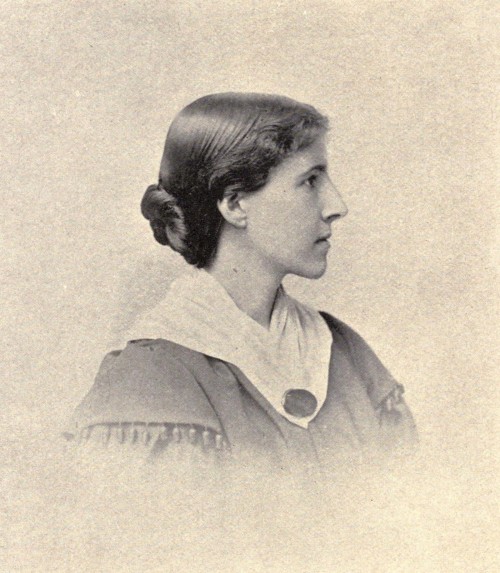
Taken a few years after the publication of "The Yellow Wallpaper," this portrait photograph shows activist Charlotte Perkins Gilman's feminine poise and respectability fifty-fifty equally she sought massive change for women'southward place in society. An outspoken supporter of women's rights, Gilman's works challenged the supposedly "natural" inferiority of women. Wikimedia.
Women vocalized new discontents through literature. Charlotte Perkins Gilman's short story "The Yellow Wallpaper" attacked the "naturalness" of feminine domesticity and critiqued Victorian psychological remedies administered to women, such equally the "residuum cure." Kate Chopin'southward The Enkindling, set in the American S, likewise criticized the domestic and familial role ascribed to women by society and gave expression to feelings of malaise, desperation, and desire. Such literature direct challenged the status quo of the Victorian era's constructions of femininity and feminine virtue, as well equally established feminine roles.
While many men worried most female activism, they worried too about their own masculinity. To anxious observers, industrial capitalism was withering American manhood. Rather than working on farms and in factories, where young men formed physical muscle and spiritual dust, new generations of workers labored behind desks, wore white collars, and, in the words of Supreme Court Justice Oliver Wendell Holmes, appeared "black-coated, potent-jointed, soft-muscled, [and] paste-complexioned."21 Neurologist George Beard even coined a medical term, neurasthenia, for a new emasculated status that was marked by depression, indigestion, hypochondria, and extreme nervousness. The philosopher William James called it "Americanitis." Academics increasingly warned that America had become a nation of emasculated men.
Churches also worried well-nigh feminization. Women had always comprised a clear majority of church memberships in the United States, but now the theologian Washington Gladden said, "A preponderance of female person influence in the Church or anywhere else in society is unnatural and injurious." Many feared that the feminized church had feminized Christ himself. Rather than a crude-hewn carpenter, Jesus had been made "mushy" and "sweetly effeminate," in the words of Walter Rauschenbusch. Advocates of a so-called muscular Christianity sought to stiffen young men'south backbones past putting them dorsum in impact with their key manliness. Pulling from contemporary developmental theory, they believed that young men ought to evolve as civilization evolved, advancing from primitive nature-dwelling to modern industrial enlightenment. To facilitate "archaic" encounters with nature, muscular Christians founded summer camps and outdoor boys' clubs like the Woodcraft Indians, the Sons of Daniel Boone, and the Boy Brigades—all precursors of the Boy Scouts. Other champions of muscular Christianity, such every bit the newly formed Young Men's Christian Association, built gymnasiums, often attached to churches, where youths could strengthen their bodies too every bit their spirits. It was a Young Men'south Christian Association (YMCA) leader who coined the term bodybuilding, and others invented the sports of basketball and volleyball.22
Muscular Christianity, though, was about even more than edifice strong bodies and minds. Many advocates likewise ardently championed Western imperialism, cheering on attempts to civilize non-Western peoples. Gilded Historic period men were encouraged to embrace a particular vision of masculinity continued intimately with the ascent tides of nationalism, militarism, and imperialism. Contemporary ideals of American masculinity at the turn of the century developed in concert with the Usa' imperial and militaristic endeavors in the Westward and away. During the Spanish-American War in 1898, Teddy Roosevelt and his Rough Riders embodied the arcadian image of the tall, potent, virile, and fit American homo that simultaneously epitomized the ideals of power that informed the U.s.' royal agenda. Roosevelt and others similar him believed a reinvigorated masculinity would preserve the American race's superiority against strange foes and the effeminizing effects of overcivilization.
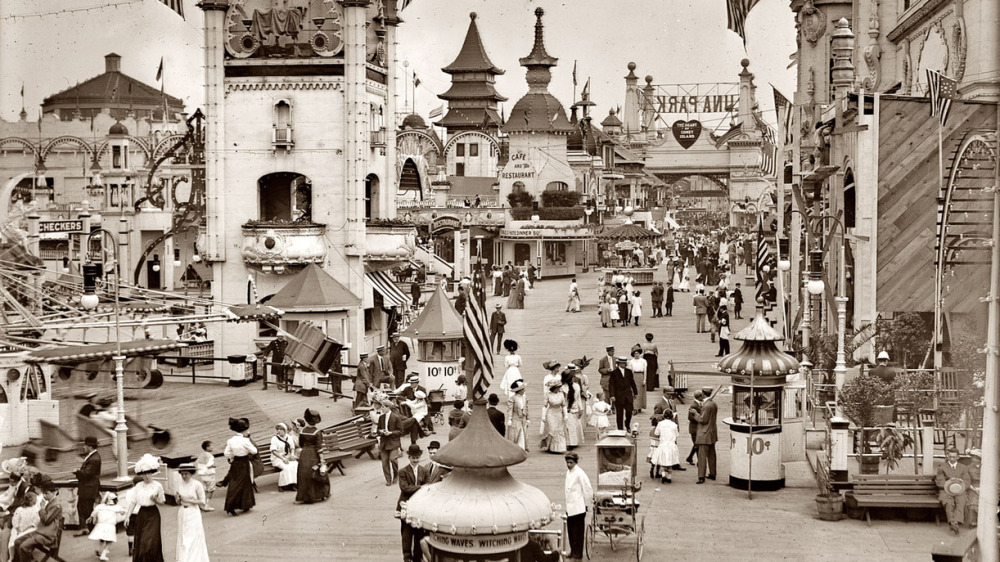
Amusement-hungry Americans flocked to new entertainments at the plough of the twentieth century. In this early-twentieth-century photograph, visitors enjoy Luna Park, one of the original entertainment parks on Brooklyn's famous Coney Island. Visitors to Coney Island's Luna Park, ca.1910-1915. Library of Congress (LC-B2- 2240-13).
But while many fretted about traditional American life, others lost themselves in new forms of mass culture. Vaudeville signaled new cultural worlds. A unique variety of pop entertainments, these traveling circuit shows first appeared during the Civil War and peaked between 1880 and 1920. Vaudeville shows featured comedians, musicians, actors, jugglers, and other talents that could captivate an audience. Unlike earlier rowdy acts meant for a male audition that included alcohol, vaudeville was considered family unit-friendly, "polite" entertainment, though the acts involved offensive ethnic and racial caricatures of African Americans and recent immigrants. Vaudeville performances were oftentimes small and quirky, though venues such as the renowned Palace Theatre in New York City signaled true stardom for many performers. Popular entertainers such as silent moving-picture show star Charlie Chaplin and sorcerer Harry Houdini fabricated names for themselves on the vaudeville excursion. But if alive entertainment still captivated audiences, others looked to entirely new technologies.
By the plough of the century, 2 technologies pioneered by Edison—the phonograph and motion pictures—stood ready to revolutionize leisure and aid create the mass entertainment civilization of the twentieth century. The phonograph was the first reliable device capable of recording and reproducing sound. But it was more than that. The phonograph could create multiple copies of recordings, sparking a great expansion of the market for popular music. Although the phonograph was a technical success, Edison at first had problem developing commercial applications for it. He idea information technology might be used for dictation, recording audio letters, preserving speeches and dying words of great men, producing talking clocks, or teaching elocution. He did not conceptualize that its greatest use would be in the field of mass amusement, but Edison's sales agents soon reported that many phonographs were being used for but that, especially in so-called phonograph parlors, where customers could pay a nickel to hear a piece of music. By the turn of the century, Americans were purchasing phonographs for dwelling utilize. Amusement became the phonograph's major market.
Inspired past the success of the phonograph as an entertainment device, Edison decided in 1888 to develop "an musical instrument which does for the Eye what the phonograph does for the Ear." In 1888, he patented the concept of motion pictures. In 1889, he innovated the rolling of picture. Past 1891, he was exhibiting a motion-picture photographic camera (a kinetograph) and a viewer (a kinetoscope). By 1894, the Edison Company had produced about seventy-five films suitable for sale and viewing. They could be viewed through a small eyepiece in an arcade or parlor. They were short, typically about three minutes long. Many of the early on films depicted athletic feats and competitions. One 1894 picture, for example, showed a six-round battle match. The catalog clarification gave a sense of the entreatment information technology had for male viewers: "Total of hard fighting, clever hits, punches, leads, dodges, body blows and some slugging." Other early kinetoscope subjects included Indian dances, nature and outdoor scenes, re-creations of historical events, and humorous skits. By 1896, the Edison Vitascope could project moving picture, shifting audiences away from arcades and pulling them into theaters. Edison's picture catalog meanwhile grew in sophistication. He sent filmmakers to afar and exotic locales similar Japan and China. Long-form fictional films created a demand for "movie stars," such equally the glamorous Mary Pickford, the swashbuckling Douglas Fairbanks, the acrobatic comedian Buster Keaton, who began to appear in the popular imagination beginning around 1910. Alongside professional battle and baseball, the motion picture manufacture was creating the modernistic culture of celebrity that would characterize twentieth-century mass entertainment.23
VI. Conclusion
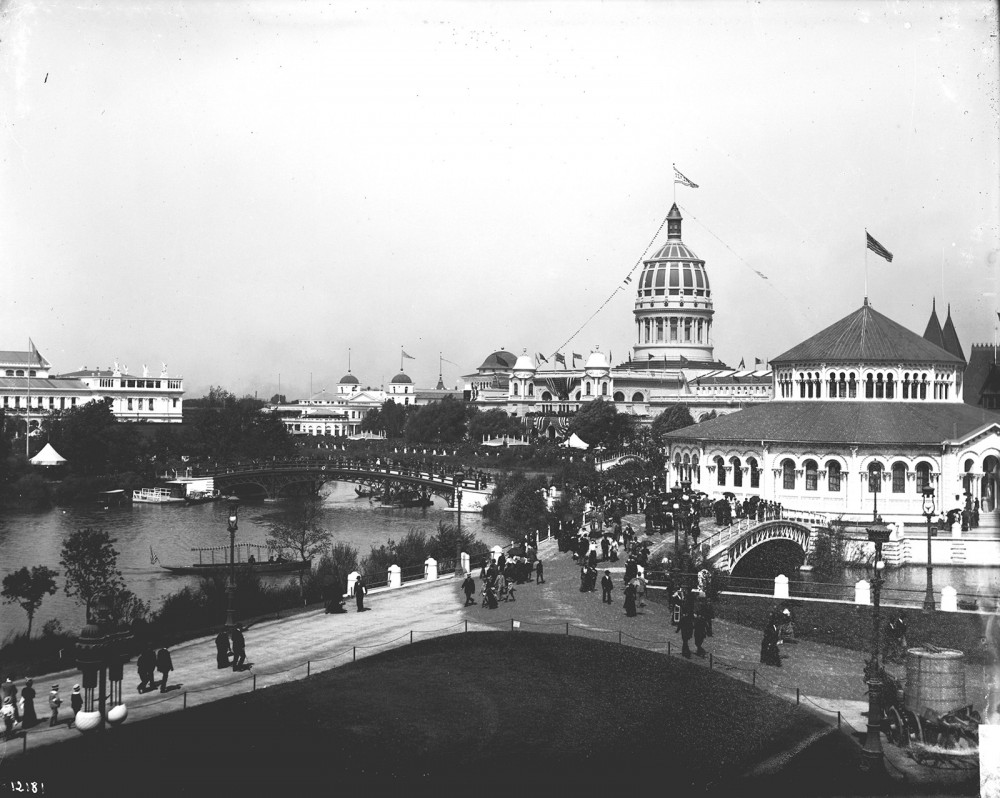
Designers of the 1893 Columbian Exposition in Chicago congenital the White City in a neoclassical architectural fashion. The integrated blueprint of buildings, walkways, and landscapes propelled the burgeoning City Beautiful motility. The Off-white itself was a huge success, bringing more than 20-7 million people to Chicago and helping to institute the credo of American exceptionalism. Wikimedia.
Subsequently enduring four encarmine years of warfare and a strained, decade-long endeavour to reconstruct the defeated Southward, the U.s. abased itself to industrial development. Businesses expanded in scale and telescopic. The nature of labor shifted. A middle grade rose. Wealth concentrated. Immigrants crowded into the cities, which grew upward and outward. The Jim Crow South stripped away the vestiges of Reconstruction, and New South boosters papered over the scars. Industrialists hunted profits. Evangelists appealed to people'southward morals. Consumers lost themselves in new goods and new technologies. Women emerging into new urban spaces embraced new social possibilities. In all of its many facets, by the turn of the twentieth century, the United States had been radically transformed. And the transformations continued to ripple outward into the W and overseas, and inward into radical protest and progressive reforms. For Americans at the twilight of the nineteenth century and the dawn of the twentieth, a bold new world loomed.
VII. Primary Sources
1. Andrew Carnegie on "The Triumph of America" (1885)
Steel magnate Andrew Carnegie celebrated and explored American economic progress in this 1885 commodity, later reprinted in his 1886 book,Triumphant Commonwealth.
2. Henry Grady on the New South (1886)
Atlanta newspaperman and campaigner of the "New South," Henry Grady, won national recognition for his December 21, 1886 speech to the New England Gild in New York City.
3. Ida B. Wells-Barnett, "Lynch Law in America" (1900)
Ida B. Wells-Barnett, born enslaved in Mississippi, was a pioneering activist and journalist. She did much to expose the epidemic of lynching in the United States and her writing and research exploded many of the justifications—particularly the rape of white women past Black men—ordinarily offered to justify the do.
4. Henry Adams,The Education of Henry Adams (1918)
Henry Adams, the great grandson of President John Adams, the grandson of President John Quincy Adams, the son of a major American diplomat, and an accomplished Harvard historian, writing in the 3rd person, describes his experience at the Keen Exposition in Paris in 1900 and writes of his come across with "forces totally new."
5. Charlotte Perkins Gilman, "Why I WroteThe Yellow Wallpaper" (1913)
Charlotte Perkins Gilman won much attending in 1892 for publishing "The Xanthous Wallpaper," a semi-autobiographical brusk story dealing with mental health and gimmicky social expectations for women. In the following piece, Gilman reflected on writing and publishing the slice.
6. Jacob Riis,How the Other One-half Lives (1890)
Jacob Riis, a Danish immigrant, combined photography and journalism into a powerful indictment of poverty in America. His 1890,How the Other Half Livesshocked Americans with its raw depictions of urban slums. Here, he describes poverty in New York.
7. Rose Cohen on the World Beyond her Immigrant Neighborhood (ca.1897/1918)
Rose Cohen was built-in in Russian federation in 1880 every bit Rahel Golub. She immigrated to the United States in 1892 and lived in a Russian Jewish neighborhood in New York's Lower East Side. Her, she writes near her see with the world outside of her ethnic neighborhood.
8. Mulberry Street (ca. 1900)
At the turn of the century, New York City'south Lower Due east Side became the most densely packed urban area in the world. This colorized photomechanical print from the Detroit Photographic depicts daily life on Mulberry Street, the area'southward fundamental artery.
9. Coney Isle (ca. 1910-1915)
Amusement-hungry Americans flocked to new entertainments at the plow of the twentieth century. In this early-twentieth century photograph, visitors savor Luna Park, one of the original amusement parks on Brooklyn's famous Coney Isle.
VIII. Reference Fabric
This chapter was edited by David Hochfelder, with content contributions past Jacob Betz, David Hochfelder, Gerard Koeppel, Scott Libson, Kyle Livie, Paul Matzko, Isabella Morales, Andrew Robichaud, Kate Sohasky, Joseph Super, Susan Thomas, Shawn Varghese, Kaylynn Washnock, and Kevin Young.
Recommended commendation: Jacob Betz et al., "Life in Industrial America," David Hochfelder, ed., in The American Yawp, eds. Joseph Locke and Ben Wright (Stanford, CA: Stanford University Printing, 2018).
Recommended Reading
- Ayers, Edward. The Promise of the New South. New York: Oxford University Printing, 1992.
- Beckert, Sven. Monied Urban center: New York City and the Consolidation of the American Bourgeoisie, 1850–1896. Cambridge, United kingdom of great britain and northern ireland: Cambridge University Printing, 2001.
- Bederman, Gail. Manliness and Civilization: A Cultural History of Gender and Race in the United States, 1880–1917. Chicago: University of Chicago Press, 1995.
- Blight, David. Race and Reunion: The Ceremonious War in American Memory. Cambridge, MA: Harvard University Press, 2001.
- Briggs, Laura. "The Race of Hysteria: 'Overcivilization' and the 'Fell' Adult female in Late Nineteenth-Century Obstetrics and Gynecology." American Quarterly 52 (June 2000). 246–273.
- Chauncey, George. Gay New York: Gender, Urban Civilization, and the Making of the Gay Male person World, 1890–1940. New York: Bones Books, 1995.
- Cole, Stephanie, and Natalie J. Band, eds. The Folly of Jim Crow: Rethinking the Segregated South. College Station: Texas A&Thousand Academy Printing, 2012.
- Cott, Nancy. The Grounding of Modern Feminism. New Haven, CT: Yale University Press, 1987.
- Cronon, William. Nature's City: Chicago and the Nifty West. New York: Norton, 1991.
- Edwards, Rebecca. New Spirits: Americans in the Gilded Age, 1865–1905. New York: Oxford University Press, 2005.
- Gilmore, Glenda Elizabeth. Gender and Jim Crow: Women and the Politics of White Supremacy in North Carolina, 1896–1920. Chapel Hill: University of Northward Carolina Press, 1996.
- Gutman, Herbert. Work, Civilization and Gild in Industrializing America: Essays in American Working-Course and Social History. New York: Knopf, 1976.
- Hale, Grace Elizabeth. Making Whiteness: The Culture of Segregation in the Southward, 1890–1940. New York: Pantheon Books, 1998.
- Hicks, Cheryl. Talk with You lot Like a Woman: African American Women, Justice, and Reform in New York, 1890–1935. Chapel Hill: University of N Carolina Press, 2010.
- Kasson, John F. Amusing the Million: Coney Island at the Turn of the Century. New York: Hill and Wang, 1978.
- Leach, William. State of Want: Merchants, Power, and the Rising of a New American Culture. New York: Random Firm, 1993.
- Lears, T. J. Jackson. No Place of Grace: Antimodernism and the Transformation of American Culture, 1880–1920. Chicago: University of Chicago Printing, 1981.
- Odem, Mary. Delinquent Daughters: Protecting and Policing Boyish Female Sexuality in the U.s.a., 1885–1920. Chapel Hill: University of North Carolina Press, 1995.
- Peiss, Kathy. Cheap Amusements. Working Women and Leisure in Plow-of-the-Century New York. Philadelphia: Temple University Press, 1986.
- Peiss, Kathy. Hope in a Jar: The Making of America's Beauty Culture. Philadelphia: University of Pennsylvania Press, 1999.
- Putney, Clifford. Manhood and Sports in Protestant America, 1880–1920. Cambridge, MA: Harvard University Press, 2001.
- Silber, Nina. The Romance of Reunion: Northerners and the South, 1865–1900. Chapel Hill: University of North Carolina Printing, 1997.
- Strouse, Jean. Alice James: A Biography. New York: Houghton Mifflin, 1980.
- Trachtenberg, Alan. The Incorporation of America: Culture and Society in the Golden Age. New York: Hill and Wang, 2007.
- Woodward, C. Vann. Origins of the New Southward, 1877–1913. Baton Rouge: LSU Press, 1951.
Notes
Source: https://www.americanyawp.com/text/18-industrial-america/
0 Response to "Weã¢â‚¬â„¢ll Meet Again the Breakdown of Family Relationships After World War Two"
Post a Comment